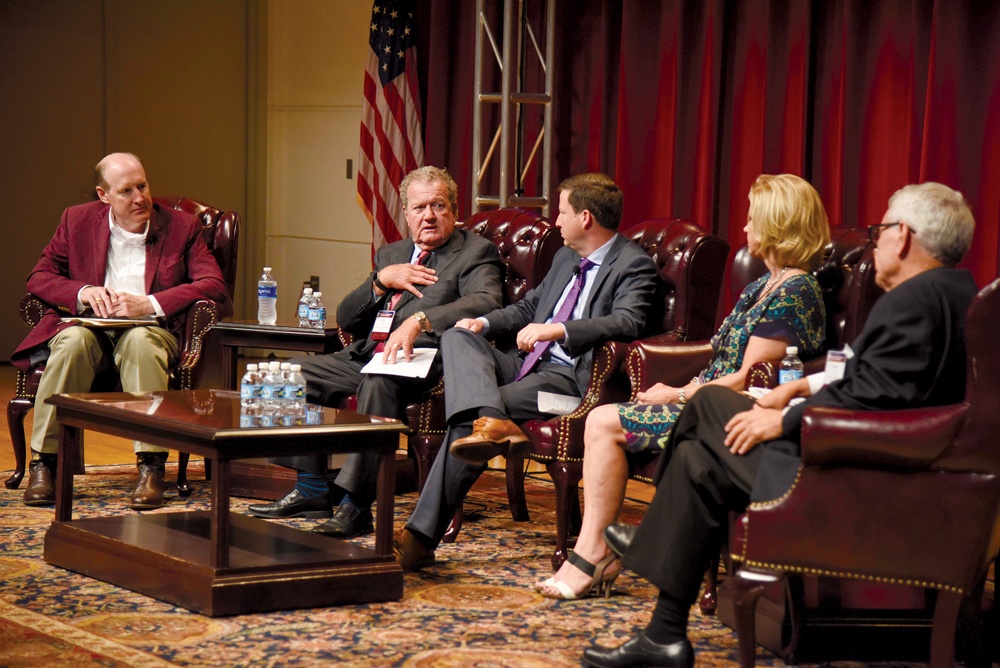Optimism about future transportation funding and new efforts to modify regulatory restrictions were prominent themes of Texas A&M University’s National Symposium on the Barriers and Opportunities for Infrastructure Renewal, held at the Annenberg Presidential Conference Center Sept. 18. Members of the Trump Administration and other high-level state and federal officials, as well as private-sector stakeholders, were in attendance.
Although focused on transportation, the symposium addressed energy, water and wastewater systems, electric grids, and other systems considered critical infrastructure sectors.
“Being able to exchange ideas, to openly discuss these topics, to gather your thoughts and your concerns will help us frame a report we will share with President Trump and his administration, with Congress, and with the national conferences of mayors, as well as state legislators,” John Barton, associate vice chancellor of The Texas A&M University System, told attendees at a gathering the night before the symposium.
The symposium occurred while construction is under way at the A&M System’s RELLIS Campus, a 2000-acre high-tech research and education complex, which will house many of the university engineering agencies, including the Texas A&M Transportation Institute (TTI), the Texas A&M Engineering Experiment Station (TEES), and the Texas A&M Engineering Extension Service (TEEX).
The Center for Infrastructure Renewal, currently under construction and a centerpiece of RELLIS, is a 138,000 square-foot research, testing and training facility focused on building longer-lasting infrastructure in less time and for less money.
“TEES, TEEX, TTI and the Bush School are masters — as good as it gets — when it comes to infrastructure,” A&M System Chancellor John Sharp said at the pre-symposium gathering. “And then you add the new Center for Infrastructure Renewal that these legislators provided us. I personally think it will be an awesome place for a national laboratory on infrastructure before it’s over with.”
Many of the panel participants at the symposium reminded the audience that rebuilding the “nation’s crumbling infrastructure” (the American Society of Civil Engineers gave the nation’s infrastructure a D+ rating in 2017, renewed from its 2013 report) will take numerous approaches — including creating new funding sources, removing some of the layers of bureaucracy, and educating the public about the benefits of specific projects at the local level.
“We have to make sure we have those regulatory reforms that are absolutely essential so we get the government out of the way,” stated keynote speaker Bill Shuster, chair of the U.S. House of Representatives Committee on Transportation and Infrastructure. “Time is money, and some of these projects linger on. We are very focused to make sure we get those kinds of reforms in place.”
Shuster said we need to consider everything to increase funding for infrastructure, including public-private partnerships, a user-fee system and an increase in the fuel tax.
The second keynote speaker, Finch Fulton, deputy assistant secretary for transportation policy at the U.S. Department of Transportation, told attendees that the new administration has made infrastructure one of its top priorities. President Trump has appointed, for the first time ever, a special advisor on infrastructure, a special advisor on environmental quality, and a task force on regulatory reform.
“The president is a builder. He’s felt the pain that you feel when trying to push forward an infrastructure project,” Fulton said. “As many of you know, you must get up to 16 different approvals from 10 different agencies covered by 29 different statutes and at least five executive orders to get anything done — for a highway project for example.”
Fulton described the president’s infrastructure initiative as $200 billion in new federal funding that will be leveraged into $1 trillion over the course of 10 years.
“There are lots of challenges out there, but it’s a wonderful time for transportation in Texas and throughout the country because of the leadership we are seeing on the federal level, in the private sector, and in our research institutes,” Tryon Lewis of the Texas Transportation Commission said. “This is an exciting time.”
A&M System agencies partnering on the symposium were TTI, TEES, TEEX, the Texas A&M College of Engineering, and the Bush School of Government and Public Service. Private-sector cosponsors were HNTB at the silver level and Econolite Group, Inc., at the bronze level
“Assessing our existing infrastructure to determine how we can make it more resilient and figuring out how best to incorporate advanced technologies to meet tomorrow’s transportation challenges are the focus of a number of TTI research initiatives going forward,” says TTI Agency Director Greg Winfree, who moderated a panel discussion on eliminating regulatory roadblocks to delivering infrastructure projects. “Deep conversations by thought leaders like those we hosted here at Texas A&M are how we’ll accomplish those goals.”
###
This story originally appeared on the TTI website.




